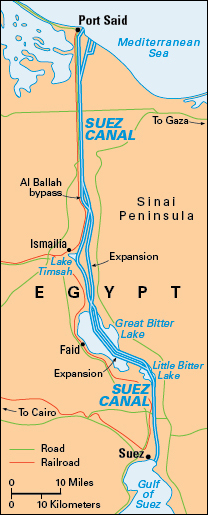Suez << soo EHZ >> crisis began on July 26, 1956, when the Egyptian government took control of the Suez Canal from its French and British owners. Egyptian president Gamal Abdel Nasser ordered the take-over after the United Kingdom and the United States withdrew their offers to help pay for the Aswan High Dam. Israel, the United Kingdom, and France used the canal take-over to justify an attack on Egypt in October 1956. However, international pressure forced the attackers to end their military operations the following month.

In the 1950’s, Western countries, led by the United States, and Communist countries, led by the Soviet Union, both tried to gain influence in Egypt. The two blocs (groups of countries) were engaged in an intense rivalry known as the Cold War. Nasser wanted Egypt to remain neutral in the Cold War. He sought funding from both sides for economic development projects in Egypt. In September 1955, Nasser signed an arms deal with Communist Czechoslovakia. Under the agreement, Egypt received military equipment, including Soviet aircraft and tanks, in exchange for cotton and rice. The United Kingdom and the United States opposed this deal. They were also troubled by Egypt’s refusal to join an anti-Communist alliance and by its recognition of the Communist government in China.
In July 1956, the United States and the United Kingdom abruptly decided not to provide the funding they had earlier promised for construction of the Aswan High Dam. Nasser, angered by this action, quickly responded by nationalizing (taking control of) the Suez Canal Company, the international company that owned the Suez Canal. He planned to use revenue from the canal to pay for the dam. The canal continued to operate normally after the take-over.
Loading the player...Suez Canal crisis
The United Kingdom and France, which held controlling interest in the Suez Canal Company, began concentrating troops in the eastern Mediterranean area. At the time, Israel was also preparing for conflict with Egypt. Israeli and Egyptian troops had been engaging in raids and counterraids in the Gaza Strip, the Egyptian-administered part of Palestine. France, the United Kingdom, and Israel joined together in a secret plan to overthrow Nasser and regain control of the canal.
On Oct. 29, 1956, Israeli forces invaded Egypt and advanced across the Sinai Peninsula toward the canal. The United Kingdom and France demanded that both Israel and Egypt withdraw from the canal zone and allow a joint British-French force to occupy the area. On October 31, the United Kingdom and France began air strikes against Egypt. In early November, French and British troops captured Port Said and Port Fuad, two large ports in the canal zone. Thousands of Egyptian civilians and soldiers were killed or wounded in the fighting.
The United States, the Soviet Union, and many other countries condemned the invasion. The Soviet Union threatened armed intervention, and the United States warned of the possibility of a nuclear confrontation between the Soviet and Western blocs. Faced with this pressure, the United Kingdom and France agreed to a cease-fire on November 6. A United Nations (UN) peacekeeping force was sent to Egypt. The UN force finished evacuating the French and British troops in December. Israeli forces, which had occupied the entire Sinai Peninsula, withdrew from that area in March 1957 under pressure from the United States.
Despite his military losses, Nasser was regarded in Egypt as a victor, and he became an Arab hero for standing up to the West. The United Kingdom and France were compensated for the shares they had held in the canal. But the two countries lost influence in the Middle East. Anthony Eden, the British prime minister, received harsh criticism for his handling of the Suez crisis. On Jan. 9, 1957, he resigned. The Suez crisis proved that the United States and the Soviet Union had become the leading powers in world politics.
